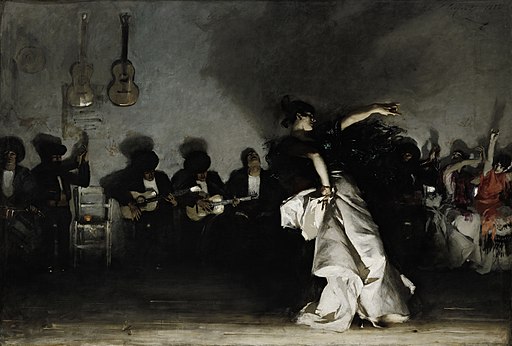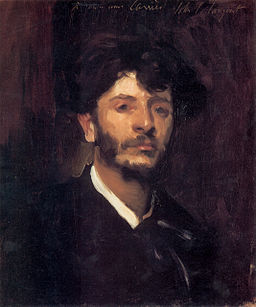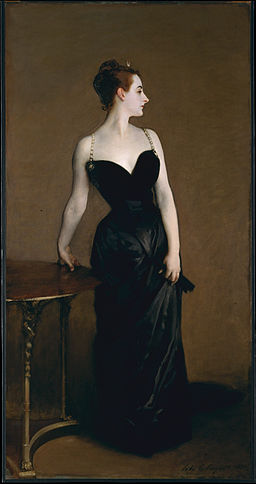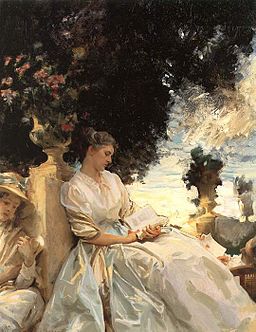A portrait is a picture in which there is something not quite right about the mouth.
—John Singer Sargent

Portrait of Sarah Choate Sears, 1899
Probably one of the most renown portrait artists of the last century, John Singer Sargent was born on January 12, 1856 in Florence, where his American family lived at the time. Sargent's family travelled extensively throughout his childhood, and it was his Italian influences, namely Tintoretto for his vivid brushwork that would have a lasting impact on the young artist. When Sargent trained under Carolus-Duran, a up-and-coming French painter from Lille, he taught Sargent about alla prima and the lively brushwork of Velázquez and drawing with the brush. This would lead Sargent to travel himself to Spain and study Velázquez up close, subsuming him into what would become Sargent's trademark sort of 'tight' impressionism that is often imitated today by portraitists. Despite this loose and vivacious brushwork Sargent's methods were extremely perfectionistic, to the point of being like Stanley Kubrick's infinite takes on a film set...Sargent was equally ruthless on numerous sittings (and paint) to capture his subjects. Thick and generous amounts of paint were a key component of Sargent's brushstrokes, and if even the slightest problem appeared Sargent would scrape off the canvas completely and start all over again, often numerous times.
In Portrait of Sarah Choate Sears above Sargent's fickle brushwork is hypnotic to see up close. Paying particular attention to color temperatures and the use of light, he creates an elegant portrait of this famous American art collector as well as artist and photographer from Massachusetts. Thick paint or not, Sargent always refined his edges carefully except in areas like his drapery, which he interpreted strictly in terms of color value and chroma. Her face has deep character and intelligence, which Sargent captures by paying close attention to those eyes and the gracefulness of her hands. Note how he creates the illusion of transparency by strokes of pink on arms and neck. The eyebrows are merely a few strokes of raw umber.

The Daughters of Edward Darley Boit, 1882
This famous portrait of four young girls is a massive square painting (87.6 in × 87.6 in) depicting the daughters of a wealthy American living in Paris. Many comparisons have been made of this painting to Las Meninas by Velázquez for its deep shadows and unusual arrangement of the figures. Sargent places the two daughters in dark blue-green and white perpendicular to each other, with the second facing us, her face off center of the painting. The other faces the corner of the room leaning against the giant vase, sulking as if not wanting to be there. Both are in shadow as if to suggest their possible conniving nature. The girl in red is in a vertical space by herself with the corner of the area rug pointing at her to imply her unique beauty and importance in the family, arms proudly behind her back. The adorable youngest is sitting on the rug playing with her doll, feet splayed together to heighten her innocence and undeveloped elegance. Sargent has captured the personalities and family ranking of these girls with a sophistication normally given to adults, but here they are highly individual and iconoclastic. The Classical formal family portrait is shattered for a more honest approach that tells more of who they are.

El Jaleo, 1882
Painted during his travels in Spain, Sargent had a keen fascination with gypsies and their music which he wanted to paint on a larger scale. Lit suggestively from below with a looming shadow behind her, Sargent attempts to recreate the rhythms and passion of spanish guitars and sensuous movements. This type of subject matter would have been indeed scandalous to European society who marginalized gypsies for their lack of work ethic and unusual superstitions. Here, Sargent exalts them as many artists did for their exuberance and joie de vivre. The sense of movement Sargent suggests by placing the dancer off center towards the right, with her body leaning backward diagonally and arm in the air, mimicked by the women behind her against the wall suggests the contagious tempo of this hypnotic music.

The Breakfast Table, 1884
A loose study that seems almost painted in one sitting, Sargent conjures a strong sense of presence for such a simple subject matter. Note the strong complementary colors with a contrast of circular and rectangular shapes. A black wedge of emptiness from an open door behind the woman is the only dark shadow in this painting, which is atypical for Sargent. Instead, he uses glass, silverware and prominent brights to heighten the mood of this scene, with cool greys and greens with an eerie yellow-green glint of light on the wall behind her. Apparently Sargent's younger sister, Violet, she appears to be cutting an orange while reading a book, and Sargent chooses to cast a cool green shadow behind her, unusual yet charming at the same time. I love this painting because it is indifferent to us, the viewer, and doesn't try to gain our attention yet by color alone it pulls us in anyway. This is one of Sargent's most underrated works.

Sargent in his studio in Paris, 1885
This spacious studio is a testament to the success and prestige of Sargent as the leading artist of the Edwardian era. On his easel is The Breakfast Table.

An Artist in His Studio, 1904
A portrait of Ambrogio Raffele, a fellow landscape painter and friend of Sargent studies his own landscape paintings on the floor beneath his easel and on the bed, palette and brushes in hand. Despite the relatively cramped quarters Raffele is painting in, Sargent focuses on the painter's state of mind and how the thought process of painting takes us away from the present moment inside our own head. Here, Sargent paints a superb profile of Raffele, slightly foreshortened, with a solid structure to the head with smooth edges. The drapery of his clothing is marked with vigorous brushwork...the back of the chair painted with thick yellow-orange tints. The shadow along the wall, especially on the pillows behind the large painting are warm and transparent. What Sargent apparently failed to learn from Velázquez however, was the contrast of brushwork and using cleaner edges to highlight important areas, and in this painting the monotony of bedsheets to the right disrupts the composition. Had he left the footboard bare except for the pale blue jacket and straw hat the painting would have improved greatly, and the corner of the footboard pointing toward Raffele would have reinforced him as the focal point. Another solution would have been to put the blue jacket on Raffele while sitting in that chair instead of a dull, muted suit.

Portrait of Jean Joseph Marie Carries, 1880
In this intriguing study of sculptor Jean Joseph Marie Carries, Sargent makes the brushstrokes themselves behave like clay, twisting and wrapping around the likeness of this studious young man. It is clear that a work such as this helped greatly to pave the way for modernist artists, yet there is still structure and emotion to the face. Sargent still pays attention to the eyes and nose, and contrary to Sargent's quote about mouths Carries' lips appear quite normal. If anything it is his earlobe that appears totally unnatural and unfinished, drawing attention to itself. In spite of this, Sargent creates plenty of presence.

Portrait of Madame X (Madame Pierre Gautreau), 1883
One of the most famous portraits of all time, Sargent hoped this elegant and minimalist portrait would propel his career but instead caused an unusual controversy and ruined his reputation in France. Although tasteful and classy to our modern eyes, in the Edwardian and Belle Époque eras the fashion for women was to be seemingly covered from neck to ankle. This low neckline was apparently too much even for the French, and in the original her right strap was dangling off her shoulder. Had Sargent painted this a mere ten years later or so in Paris the reception may have been different. The woman, Virginie Amélie Avegno Gautreau was an American who married a Parisian banker and hoped, like Sargent, that the painting would garner fame and attention for both of them when he premiered it at the Paris Salon. Gautreau was a high-profile socialite whose reputation was not quite innocent. Here Sargent defines her as confident, head in profile to accentuate her sternocleidomastoid muscle of her neck. Her cool skin alludes to an upper-class woman, and the way Sargent has painted her hands shows an attention to detail and anatomy that he never bothered with before. Even the drapery of her dress is understated and accurate. Sargent captured something not quite seen before, a kind of vulnerability and sexual poise at the same time, contemporary yet Classical— some even think it was inspired by this Mannerist fresco. It is unfortunate that a painting of this power would be criticised so much that Gautreau herself was utterly disappointed and humiliated by the negative reception...perhaps that profile looking away from us proved too arrogant for french tastes, and oddly unlike Sargent as most of his subjects look at the viewer. Years later he sold it to the Met in New York, where it resides today.

Gondolier's Siesta, 1905
One of Sargent's many watercolor paintings, this is a medium that he was perfectly natural at. His many scenic vistas such as this view in Venice, and his various portraits, show his mastery of the medium and confidence in color. The way he has suggested texture and light in the building behind the gondolieri, as well as the vibrant greens and reflections under their boats shows he was adept at many mediums, as he was with the languages he spoke growing up in Europe.

Portrait of James Whitcomb Riley, 1903
Sargent's portrait of this American writer shows a great maturity in his style, with superb attention to edges and incredibly subtle blending in the skin tones of this striking face. A ruddy complexion with pensive eyes, small-rimmed glasses, distinctive nose and a mouth that is palpably elderly reveals a sensitive portrait of an intelligent man. The dark, warm background serves to heighten the drama and soul of this writer of works such as Little Orphan Annie. This is a portrait Velázquez would have been impressed by.

Henry Lee Higginson, 1903
The founder of the Boston Symphony Orchestra, Higginson was a prominent American banker and philanthropist. In this portrait, Sargent creates an air of mystery and deep character, using the background as an element in the painting with the strong glint of golden light on the wall. A simple palette by Sargent's standards, with almost no drapery or folds, leads us to focus on the face of this man staring at us without any hesitation, bathed in a warm light. Sargent's ability to experiment and discover new ideas in palette and costume to suit the personality of the sitter is worth noting and deserving of respect, as many artists seem to get more formulaic with their success.

In a Garden, Corfu, 1873
I like this painting because it does not resemble any of Sargent's works. Deeply Classical in spirit and execution, Sargent takes a woman reading outside as something from the Renaissance or early Rococo. The smoothness of her skin and graceful profile, reading next to a large vase against a bright background sky that appears to be painted over, is quite surreal. Note the other two women on either side of her reading also, like bookends. The massive canopy of a tree above them frames the composition to enhance the peacefulness of this calm afternoon.

Interior of Dodges Palace, 1898
Despite its drama and intensity, this Venetian interior was painted on a relatively small scale for Sargent (19.8 × 27.2 in) but is no small painting. The study of warm sunlight bathing a rich interior of this splendor with accurate attention to color temperatures is a real masterwork. Squint and it looks lifelike. Note the streaks of color in the smooth marble floor.

Carolus-Duran, 1879
This famous portrait is of Sargent's art teacher and captures the essence of this confident artist, right down to the texture and color of his coat against the warm reddish background. An earlier work, one can see that despite technical proficiency, presence and understanding of the sitter, its straightforward pose and gaze lacks any real psychological insight, compared to his later work.

Street in Venice, 1882
Another early work, this moody street in one-point perspective is full of character. Silhouetted figures against a near empty street with a woman walking past timidly...Sargent was channeling cinema before its time. The ability to tell a story in painting is enormously powerful, even when simplistic, and here it makes us want to be there, somehow. The quality of light here, using a warm low-key palette, is dreamy, unreal. All that is missing are the details of signs and door entrances.

Repose, 1911
A later work, Sargent's mastery is evident here with brushstrokes that suggest shimmering fabric from bright afternoon window-light bathing her. The pose is interesting in that her hands are crossed, yet she lays back, tired as if indifferent to being painted or observed by anyone, and it gives a psychology to the painting that is unique from all of his other work. Her torso is wrapped like a package, perhaps a sweater of some sort, and she seems too tired to fight the oppression of this costume. Perhaps Sargent himself was tired of how women were being portrayed as high-fashion princesses, and instead of revealing her body he instead portrays her like furniture, stiff and awkward, and tired.
Sargent's legacy would have a lasting impact on art and portraiture, and although in this blog I have more than once indicated how overrated his status is, especially to current portrait artists who try unsuccessfully to imitate him without studying the past, his art is worth studying. He adopted the methods of the past to suit the Edwardian era he lived in, and he did it well. And he never stopped experimenting or learning. Greatness comes from taking risks and expressing all that is inside you, not just seeking fame or fortune.
Comments
Post a Comment